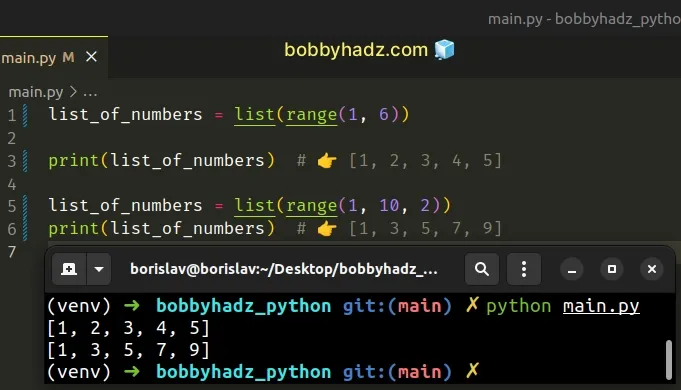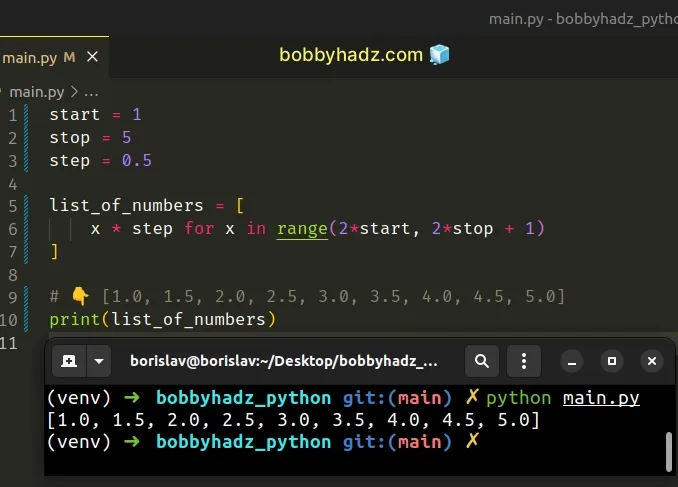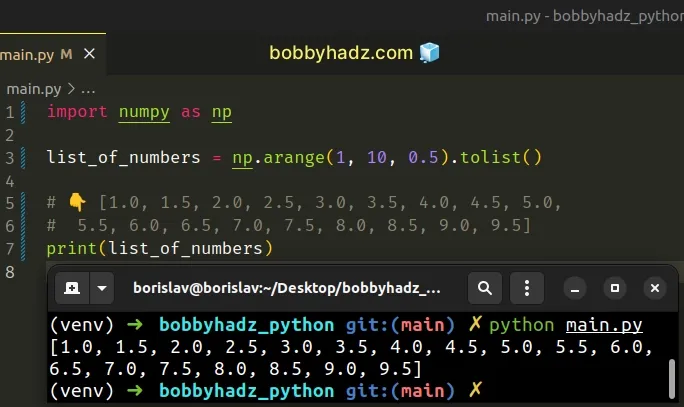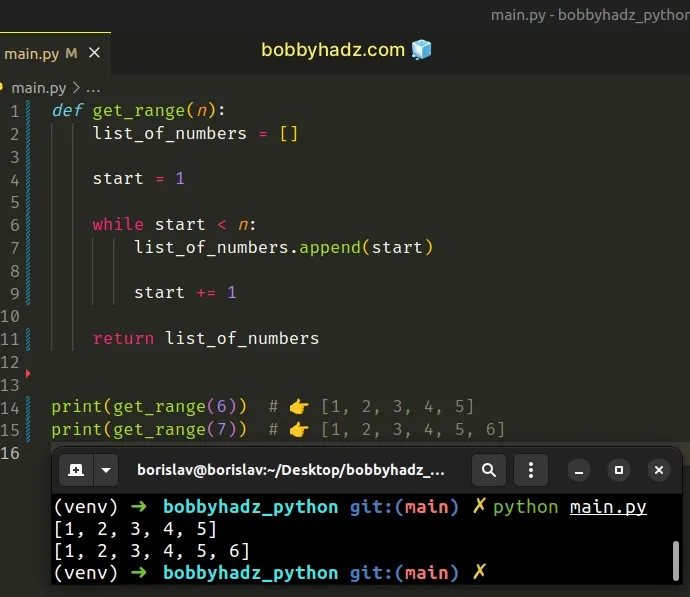Create a List of Numbers from 1 to N in Python
Last updated: Apr 10, 2024
Reading time·5 min

# Table of Contents
- Create a list of numbers from 1 to N in Python
- Create a list of numbers from 1 to N using a list comprehension
- Using a floating-point number for the
stepwithnumpy - Create a list of numbers from 1 to N using a list comprehension
- Create a list of numbers from 1 to N using a
forloop - Create a list of numbers from 1 to N using a
whileloop
# Create a list of numbers from 1 to N in Python
To create a list of numbers from 1 to N:
- Use the
range()class to create arangeobject from 1 to N. - Use the
list()class to convert therangeobject to a list. - The new list will contain the numbers in the specified range.
list_of_numbers = list(range(1, 6)) print(list_of_numbers) # 👉️ [1, 2, 3, 4, 5] list_of_numbers = list(range(1, 10, 2)) print(list_of_numbers) # 👉️ [1, 3, 5, 7, 9]

The range() class is commonly used for looping
a specific number of times in for loops and takes the following arguments:
| Name | Description |
|---|---|
start | An integer representing the start of the range (defaults to 0) |
stop | Go up to, but not including the provided integer |
step | Range will consist of every N numbers from start to stop (defaults to 1) |
If you only pass a single argument to the range() constructor, it is
considered to be the value for the stop parameter.
list_of_numbers = list(range(5)) # 👇️ [0, 1, 2, 3, 4] print(list_of_numbers)
start argument is omitted, it defaults to 0 and if the step argument is omitted, it defaults to 1.If values for the start and stop parameters are provided, the start value
is inclusive, whereas the stop value is exclusive.
list_of_numbers = list(range(1, 5)) # 👇️ [1, 2, 3, 4] print(list_of_numbers)
If you need to specify a step, pass a third argument to the range() class.
list_of_numbers = list(range(1, 10, 2)) print(list_of_numbers) # 👉️ [1, 3, 5, 7, 9]
The list contains every second number starting from 1 to 10.
The step argument can only be set to an integer.
# Create a list of numbers from 1 to N using a list comprehension
You can also use a list comprehension to create a list of numbers from 1 to N.
start = 1 stop = 5 step = 0.5 list_of_numbers = [ x * step for x in range(2*start, 2*stop + 1) ] # 👇️ [1.0, 1.5, 2.0, 2.5, 3.0, 3.5, 4.0, 4.5, 5.0] print(list_of_numbers)

The list in the example starts at 1 and goes to 5 (inclusive) in increments of
0.5.
You can update the start, stop and setup values.
This approach is useful when you have a step value that is not an integer
because the range() class only supports integer values.
# Using a floating-point number for the step with numpy
If you need to use a floating-point number for the step, use the
numpy.arange() method.
import numpy as np list_of_numbers = np.arange(1, 10, 0.5).tolist() # 👇️ [1.0, 1.5, 2.0, 2.5, 3.0, 3.5, 4.0, 4.5, 5.0, # 5.5, 6.0, 6.5, 7.0, 7.5, 8.0, 8.5, 9.0, 9.5] print(list_of_numbers)

The numpy.arange() method returns an array of evenly spaced values within the given interval.
We used the tolist() method to convert the array to a list.
If you need to install the NumPy package, run the following command.
pip install numpy # 👇️ or pip3 pip3 install numpy
You can omit the step argument to get a list of values from 1 to N in
increments of 1.
import numpy as np list_of_numbers = np.arange(1, 11).tolist() # 👇️ [1, 2, 3, 4, 5, 6, 7, 8, 9, 10] print(list_of_numbers)
The numpy.arange() method is very similar to the range() class but allows
for step values that are floating-point numbers.
# Create a list of numbers from 1 to N using a list comprehension
You can also use a list comprehension to create a list of numbers from 1 to N.
list_of_numbers = [number for number in range(1, 6)] print(list_of_numbers) # 👉️ [1, 2, 3, 4, 5]
On each iteration, we return the current number.
The new list contains the numbers in the range object.
However, this isn't necessary unless you need to perform some operation for
every number in the range object.
# Create a list of numbers from 1 to N using a for loop
The same can be achieved using a simple for loop.
list_of_numbers = [] for number in range(1, 6): list_of_numbers.append(number) print(list_of_numbers) # 👉️ [1, 2, 3, 4, 5]
We used a for loop to iterate over the range object.
On each iteration, we use the list.append() method to append the current
number to a list.
The list.append() method adds an item to the end of the list.
my_list = ['bobby', 'hadz'] my_list.append('com') print(my_list) # 👉️ ['bobby', 'hadz', 'com']
Using the list() class to convert the
range object to a list should be sufficient unless you have to perform some
operation for every number in the range object.
You can also define a reusable function that creates a list of numbers in a
for loop.
def get_range(n): list_of_numbers = [] for number in range(1, n + 1): list_of_numbers.append(number) return list_of_numbers print(get_range(6)) # 👉️ [1, 2, 3, 4, 5, 6] print(get_range(7)) # 👉️ [1, 2, 3, 4, 5, 6, 7]
The function takes n as a parameter and creates a list of numbers from 1 to n.
# Create a list of numbers from 1 to N using a while loop
You can also use a while loop to create a list of numbers from 1 to N.
def get_range(n): list_of_numbers = [] start = 1 while start < n: list_of_numbers.append(start) start += 1 return list_of_numbers print(get_range(6)) # 👉️ [1, 2, 3, 4, 5] print(get_range(7)) # 👉️ [1, 2, 3, 4, 5, 6]

The get_range function takes n as a parameter and creates a list of numbers
from 1 to n.
On each iteration, we append the current start value to the list and increment
it.
Once the start value is equal to or greater than n, the condition is no
longer met and the while loop exits.
# Additional Resources
You can learn more about the related topics by checking out the following tutorials:
- Find Max and Min in List without max() and min() in Python
- Find second Smallest or Largest number in a List in Python
- Multiply each element in a List by a Number in Python
- Remove the Max and Min numbers from a List in Python
- Subtract a Value from every Number in a List in Python
- TypeError: Can not infer schema for type: <class 'float'>

